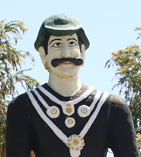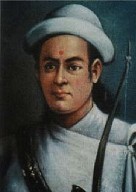| Family of Amar Singh Thapa (Elder) | |
|---|---|
 Nishankalika flag of Bagale Thapa clan, Amar Singh’s ancestral clan | |
| Current region | Gorkha & Kathmandu |
| Earlier spellings | Bagale Thapa |
| Place of origin | Siranchowk, Gorkha |
| Members |
|
| Connected members | |
| Connected families | Kunwar family |
| Traditions | Kshatriya (Chhetri) |
| Estate(s) | Siranchowk of Gorkha |
Bagh Bhim Singh Thapa was the first national military commander of this family. | |
The family of Badakaji Amar Singh Thapa [note 1] (1751 - 1816) was a noble Chhetri family in the central politics of Kingdom of Nepal as well as former military aristocracy of the Gorkha Kingdom. The family of Bhimsen Thapa and the family of Amar Singh Thapa were two Bagale Thapa families [1] [2] and part of the larger Thapa caucus at the central politics of the Kingdom of Nepal. [3]
Contents
- Significance
- Immediate family
- Children
- Grandchildren
- Ancestry
- Parents
- Grandparents
- Genealogical table
- Other relatives
- Chandrabir Kunwar
- Later Descendants
- References
- Footnote
- Notes
- Sources
The patriarch of this family was Ranjai Thapa of Siranchowk whose son Bagh Bhim Singh Thapa became a military commander of the Gorkha Kingdom and died in the battle of Palanchowk. Bhim Singh's son and the most prominent member of this family, Amar Singh Thapa went on to become the overall commander (in capacity of Mukhtiyar) of Kumaon, Garhwal and its West region in the Kingdom of Nepal. Amar Singh's sons and grandsons were influential Bharadars (state-bearing officers), politicians, ministers and military commanders in the Kingdom of Nepal. The family was also maritally connected with the Kunwar family of Gorkha. Amar Singh Thapa was the father-in-law of Chandrabir Kunwar, the nephew of Gorkhali Sardar Ramakrishna Kunwar. Through Chandrabir, Amar Singh had grandsons of national recognition; Balbhadra Kunwar, a famed warrior of the Battle of Nalapani and Birbhadra Kunwar, a Bharadar (state bearing officer).



